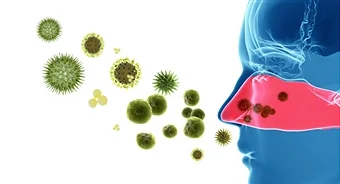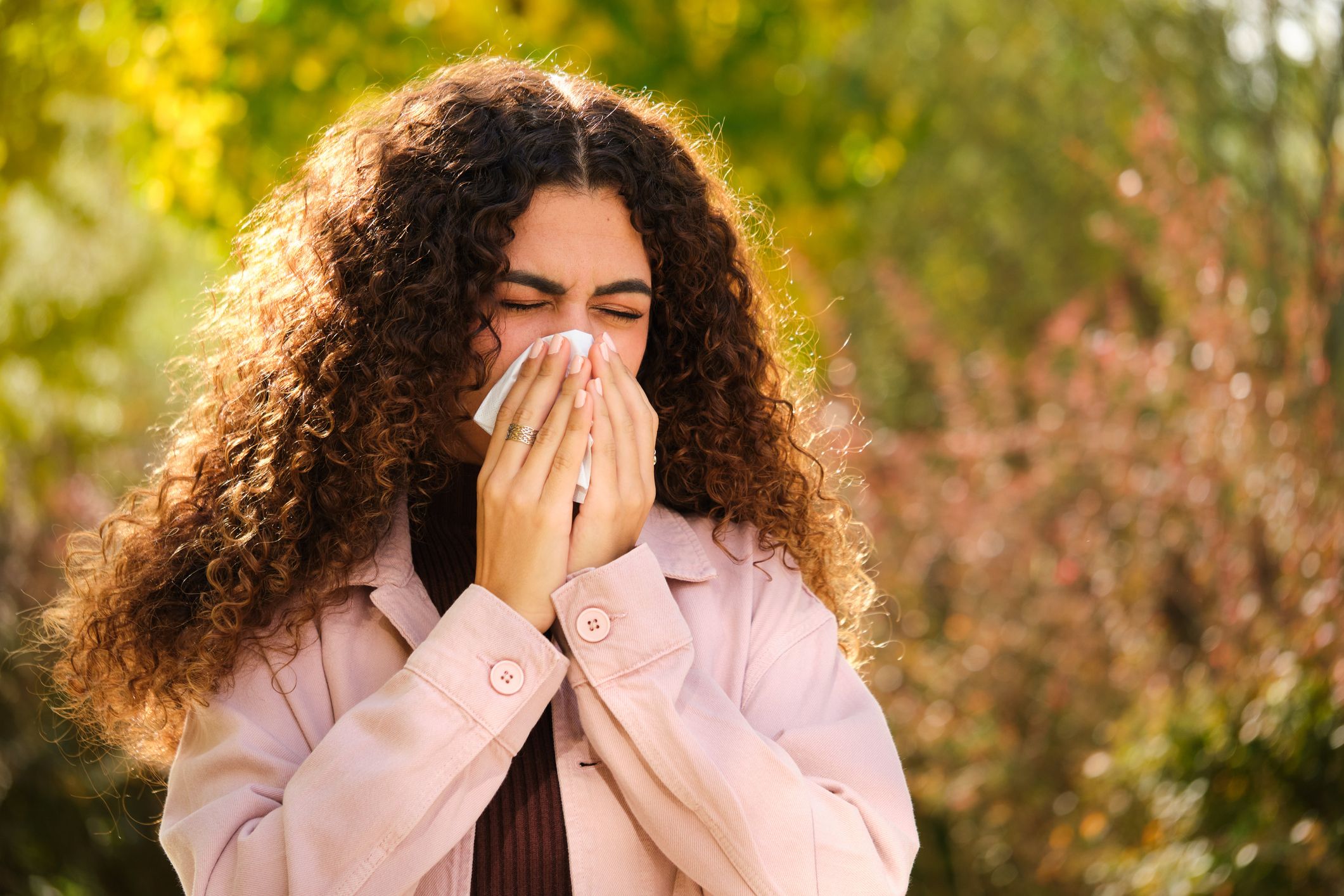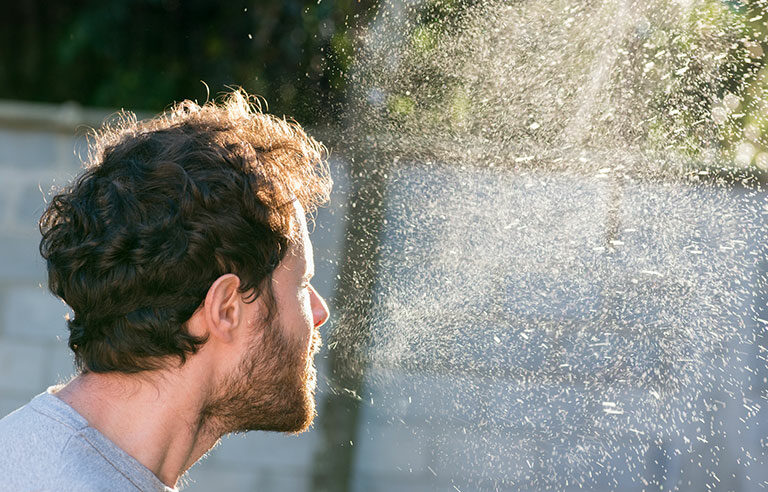A Sneeze Can Travel How Far? Much farther than you might think. When you sneeze, you release a burst of air carrying thousands of tiny droplets at speeds up to 100 miles per hour.
Scientific research shows that a sneeze can travel as far as 26 feet (8 meters), especially in closed or poorly ventilated spaces.
These droplets vary in size—larger ones fall quickly to the ground, but smaller aerosol particles can stay suspended in the air for minutes, increasing the risk of spreading viruses and bacteria.
Environmental factors like airflow, humidity, and room size can all affect how far and how long these particles linger.
Compared to a cough, a sneeze is typically more forceful and projects droplets over a wider area. That’s why sneezing is a key contributor to the spread of airborne illnesses like the flu, colds, and COVID-19.
To minimize the risk of transmission, always sneeze into a tissue or the inside of your elbow, wash your hands immediately, and maintain social distance if you’re feeling unwell. In shared spaces, proper ventilation and the use of masks can significantly reduce exposure to airborne particles.
Understanding the power and reach of a single sneeze highlights the importance of basic hygiene and respiratory etiquette—small actions that protect everyone around you.
What Happens When You Sneeze?
When you sneeze, your body is performing a rapid, protective reflex to clear irritants from your nose or throat. It all starts when something—like dust, pollen, smoke, or even a strong smell—stimulates the sensitive lining inside your nasal passages.
This triggers a signal to your brain, specifically the sneeze center in the medulla, which responds by coordinating a powerful series of muscular actions.
First, you take a deep breath. Then, the muscles in your chest, diaphragm, and throat contract, building up pressure in your lungs. Your tongue presses against the roof of your mouth and your vocal cords close, briefly trapping the air.
Finally, everything releases in a sudden burst—your eyes close involuntarily, and air, mucus, and thousands of tiny droplets are expelled through your nose and mouth at high speed.
This high-speed spray can travel at up to 100 miles per hour and contain more than 100,000 germs. While it’s meant to protect your body by ejecting irritants, it can also spread infectious agents like cold or flu viruses if you’re sick.
Sneezing is a natural defense mechanism, but because of the powerful force and wide dispersion of droplets, it’s important to cover your nose and mouth when you sneeze to prevent spreading germs to others.
How Far Can a Sneeze Actually Travel?

A sneeze can actually travel much farther than most people expect. According to scientific research, the droplets expelled during a sneeze can travel up to 26 feet (8 meters) in the air under certain conditions.
The speed of a sneeze can reach nearly 100 miles per hour (160 km/h), propelling both large droplets and tiny aerosols across a surprisingly wide area.
Larger droplets tend to fall to the ground within a few feet due to gravity, but smaller, lighter particles—known as aerosols—can stay suspended in the air for several minutes or even longer.
In enclosed or poorly ventilated environments, these lingering particles can drift around the room and increase the risk of airborne disease transmission.
The actual distance a sneeze travels depends on several factors, including the force of the sneeze, humidity, temperature, and airflow in the room. For example, in a still, dry room with no wind, a sneeze can remain airborne longer and travel farther than it would outdoors or in a well-ventilated space.
This data helps explain how illnesses like the flu, the common cold, and COVID-19 can spread so easily, even without direct contact.
Factors That Affect How Far a Sneeze Travels
A sneeze can actually travel much farther than most people expect. According to scientific research, the droplets expelled during a sneeze can travel up to 26 feet (8 meters) in the air under certain conditions.
The speed of a sneeze can reach nearly 100 miles per hour (160 km/h), propelling both large droplets and tiny aerosols across a surprisingly wide area.
Larger droplets tend to fall to the ground within a few feet due to gravity, but smaller, lighter particles—known as aerosols—can stay suspended in the air for several minutes or even longer.
In enclosed or poorly ventilated environments, these lingering particles can drift around the room and increase the risk of airborne disease transmission.
The actual distance a sneeze travels depends on several factors, including the force of the sneeze, humidity, temperature, and airflow in the room.
For example, in a still, dry room with no wind, a sneeze can remain airborne longer and travel farther than it would outdoors or in a well-ventilated space.
This data helps explain how illnesses like the flu, the common cold, and COVID-19 can spread so easily, even without direct contact.
Because a single sneeze can contaminate a wide area in seconds, practicing proper sneeze hygiene—such as covering your nose and mouth, using tissues, and washing your hands—is essential to protecting yourself and those around you.
Sneeze vs. Cough
Both sneezing and coughing are natural reflexes that help clear the respiratory system, but they differ in intensity, droplet spread, and potential for disease transmission.
A sneeze is generally more powerful and explosive than a cough. It can release up to 100,000 droplets at speeds approaching 100 miles per hour. These droplets can travel up to 26 feet (8 meters) and include both large and tiny aerosol particles.
Because of its force and volume, a sneeze tends to cover a larger area and suspends smaller particles in the air for longer—making it especially effective at spreading airborne germs if not properly covered.
A cough, on the other hand, is typically less forceful but still capable of projecting droplets up to 6–8 feet. It releases fewer particles than a sneeze, and while it can still transmit infectious agents like cold or flu viruses, its reach is usually more contained.
However, repeated coughing in close quarters—such as in classrooms, offices, or public transit—can still present a significant health risk, especially in poorly ventilated spaces.
In summary, sneezes tend to travel farther and release more particles, increasing the potential for rapid spread of illness. That said, both should be treated seriously.
Always cover your mouth and nose with a tissue or your elbow, and wash your hands afterward. Whether you’re sneezing or coughing, proper hygiene is key to protecting others from infection.
The Role of Airborne Particles and Droplets
When a person sneezes, coughs, talks, or even breathes, they release a mixture of droplets and airborne particles into the surrounding air. These particles vary in size, and their size plays a major role in how far they can travel and how long they can stay suspended.
Larger droplets—typically over 5 microns in diameter—are heavier and fall to the ground quickly, usually within 3 to 6 feet of the source.
These are the particles most likely to land on nearby surfaces or directly on another person, contributing to droplet-based transmission of illnesses like the common cold or flu.
Smaller particles, often referred to as aerosols, are lighter and can remain suspended in the air for extended periods—sometimes minutes or even hours, depending on ventilation and airflow.
These aerosols can drift across a room and be inhaled by others, enabling airborne transmission. This is especially concerning in poorly ventilated or enclosed spaces, where infectious particles can build up over time.
Research during the COVID-19 pandemic highlighted how aerosols contribute significantly to the spread of respiratory viruses. In fact, even after someone has sneezed or coughed and left the area, infectious aerosols can remain in the air and pose a risk to others.
Understanding the role of these particles helps explain why good ventilation, air filtration, wearing masks, and physical distancing are essential public health tools.
It also underscores the importance of covering your mouth and nose when sneezing or coughing to limit the spread of both large droplets and fine airborne particles.
Can a Sneeze Spread Germs Across a Room?
Yes, a sneeze can absolutely spread germs across an entire room. When someone sneezes, they release a high-velocity cloud of air filled with tiny droplets and aerosols—some of which can carry viruses or bacteria.
Studies have shown that droplets from a sneeze can travel up to 26 feet (8 meters), especially in indoor environments with poor ventilation.
Larger droplets tend to settle on surfaces within a few feet, but smaller aerosol particles can remain airborne for minutes or even hours. In enclosed spaces, these tiny particles can circulate throughout the room, increasing the chances of someone else inhaling them and becoming infected.
This means that even if you’re not standing right next to a person who sneezes, you could still be exposed to airborne germs if you share the same air. This is especially relevant for respiratory infections like the flu, cold, and COVID-19, which can be transmitted through both direct contact and airborne routes.
Because of this, public health experts emphasize the importance of covering your mouth and nose when sneezing, using tissues or your elbow—not your hands—and maintaining good air circulation indoors.
Wearing a mask in shared spaces, especially during flu season or outbreaks, can further reduce the risk of airborne transmission.
Tips to Reduce the Spread of Sneezes

Sneezes can release thousands of tiny droplets that carry germs, so practicing proper sneeze etiquette is essential for protecting yourself and others.
Here are some effective tips to reduce the spread of sneezes:
- Sneeze Into a Tissue or Elbow
Always cover your nose and mouth with a tissue when you feel a sneeze coming. If a tissue isn’t available, sneeze into the inside of your elbow—not your hands—to avoid spreading germs through touch. - Dispose of Tissues Immediately
Used tissues should be thrown away right after use. Leaving them around increases the risk of spreading bacteria or viruses to surfaces and people nearby. - Wash Your Hands Thoroughly
After sneezing, wash your hands with soap and water for at least 20 seconds. If that’s not possible, use a hand sanitizer that contains at least 60% alcohol. - Wear a Mask in Shared Spaces
If you’re feeling sick or it’s allergy season, wearing a mask can help prevent droplets from reaching others, especially in indoor or crowded areas. - Keep Your Distance When You’re Ill
Maintain physical distance from others if you’re sneezing frequently, whether from a cold, flu, or allergies. This lowers the risk of spreading germs through the air. - Improve Indoor Ventilation
Open windows, use air purifiers, or run exhaust fans to keep air circulating. Better airflow helps dilute and remove airborne particles released by sneezing. - Avoid Touching Your Face
Try not to touch your eyes, nose, or mouth after sneezing, especially if you haven’t washed your hands. This helps prevent self-infection and the spread of pathogens.
Conclusion
Understanding how far a sneeze can travel is more than just a scientific curiosity—it’s a crucial part of protecting public health.
A single sneeze can launch thousands of droplets at high speeds, reaching distances of up to 26 feet and staying airborne for minutes in some cases. This makes sneezing a powerful way for germs to spread, especially in enclosed or crowded spaces.
By learning how sneezes work and how far they can travel, we become more aware of how easily illnesses like the flu, colds, and even COVID-19 can be transmitted.
Simple actions like sneezing into your elbow, using tissues, wearing masks when necessary, and improving indoor ventilation can dramatically reduce that risk.
Ultimately, controlling the spread of sneeze droplets is about more than personal hygiene—it’s about caring for those around us. A small sneeze can have a big impact, but so can small steps to stop it.

